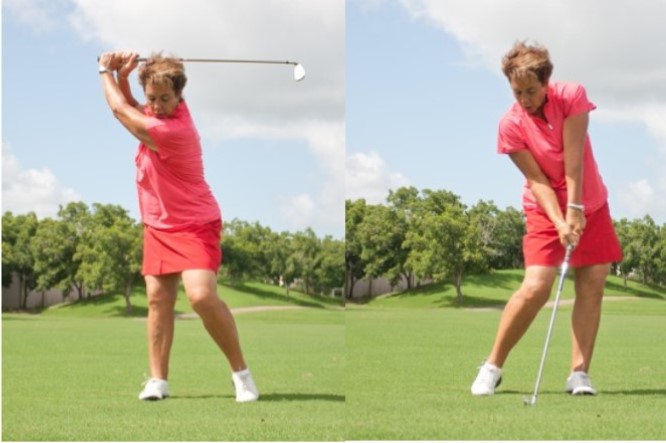Most of the right handed golfers I teach ask me about their left heel at the top of the backswing. Should it stay on the ground or is it okay to allow it to detach? I usually respond by allowing them to do either, as long as it is not a conscious thought either way and that proper transfer and torque in the swing is created without possibility of injury.
I tend to believe that the more supple you are, the less likely it will be that your left heel will detach. However, the more backswing coil you are trying to produce will make it more likely to detach. Thus, it could be likely that you will get some heel “lift” on your tee shots where you are striving for distance and perhaps less heel “lift” on your shorter iron shots for accuracy.
Many top instructors are promoting minimal or no lower body action in the backswing. While I tend to agree with quieting overactive lower body motion, I feel like this suggestion has minimized or eliminated footwork for most students. Good footwork is necessary in all sports and certainly important in the execution of an effective golf swing. I think that when your footwork is right, your lower body action can be quiet but efficient. Good footwork leads to the proper order of movement in the swing with a solid pivot and turn.
At setup, the weight is generally balanced on both feet. It should never favor being forward towards the toes, instead of over the entire (both) foot with your tendency to be more back towards the heels instead of the toes. As the backswing starts, there is a feeling of a slight weight shift off the inside of the left instep with a constant increase of weight shift to the inside of the right foot towards the right heel, onto the right leg. This sets a one-legged axis of sorts.
On the backswing, the left knee breaks inward and outward simultaneously, staying in sync with the release of the left side in the tak eaway. Too much left knee movement causes slack in the legs and a lateral slide (sway). The left knee, ideally, should point no further than your centerline. The right leg does not lock, but may slightly straighten/extend to “post up” against the braced right knee.
If you have loaded the right side well, an upper body torso turn may be easier to accomplish due to the body being in a position that enables an upper body turn against a lower body with minimal hip turn to create torque. This is like a spring being wound in your hips and torso, then unwound with a torquing power that accelerates the shoulders, arms, and club. Many believe that the hips turn about 40 – 45 degrees and the chest/shoulder turn is 80 – 90 degrees, creating the gap necessary for powerful torque. Not everyone can achieve this due to range of motion and flexibility, but a shift and turn will create good power into and through the golf ball.
The left heel, if it detaches near the top of the backswing, does so only as a chain reaction response to the coil of the upper body which in turn pulls the hip upward, exerting an upward pull on the lower left leg and foot. If it moves off the ground, the left heel is the last thing to move. My preference is to allow this to happen; don’t fight it consciously. Most people are not supple enough to make a 90 degree shoulder turn while keeping the left heel down. Additionally, we feel much of our rhythm through our feet. Detaching and replanting the left heel promotes the correct sequence and good footwork. Good footwork is the benchmark of champions in all sports. Most golfers make a much better weight transfer when they detach the heel slightly. Golfers who leave the heel down tend to swing flat footed and overuse the upper body. This not only increases the chance for injury, but there may be a significant power loss in the swing motion.
If you feel like you can accomplish this torque with your left heel down and feel comfortable with your golf swing (distance and direction), you should leave things as they are. If you are having trouble pivoting, you may have to allow your left heel to detach. When you walk, one foot releases to transfer weight onto the other foot. Thus, it may be more natural than you believe. Ben Hogan, Jack Nicklaus, Byron Nelson, Bobby Jones, Sam Snead, Hale Irwin, Tom Watson, Nick Price, Ben Crenshaw, Johnny Miller, Laura Davies, Julie Inkster, Patty Sheehan, and Karrie Webb seem to think it is a natural thing to do. Either way, work on your strength/flexibility and you will be able to create more energy in your swing motion!





















